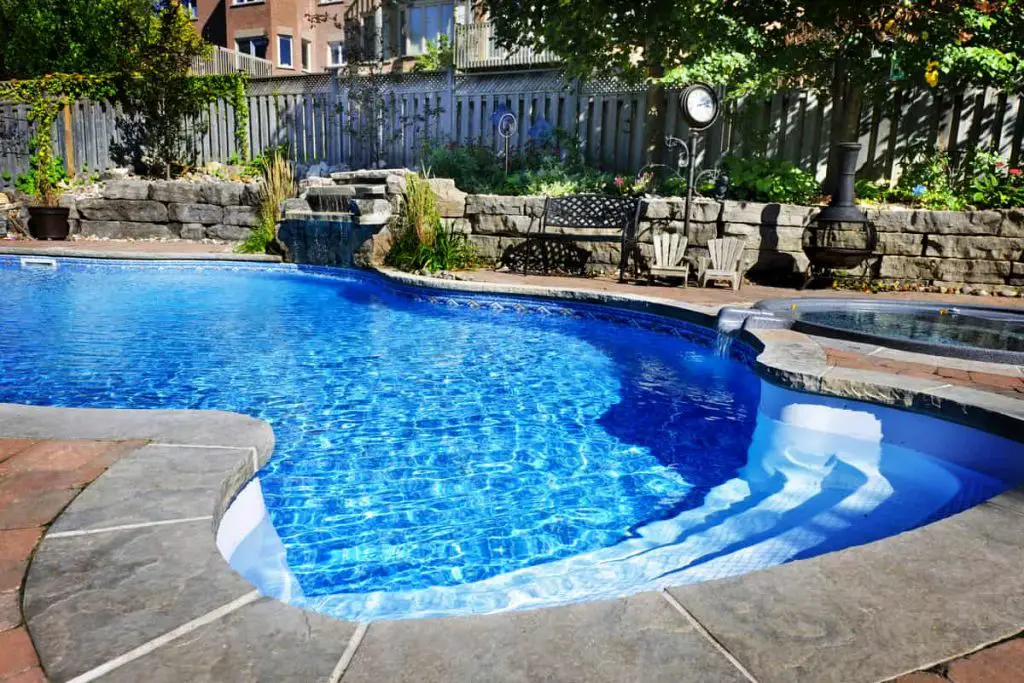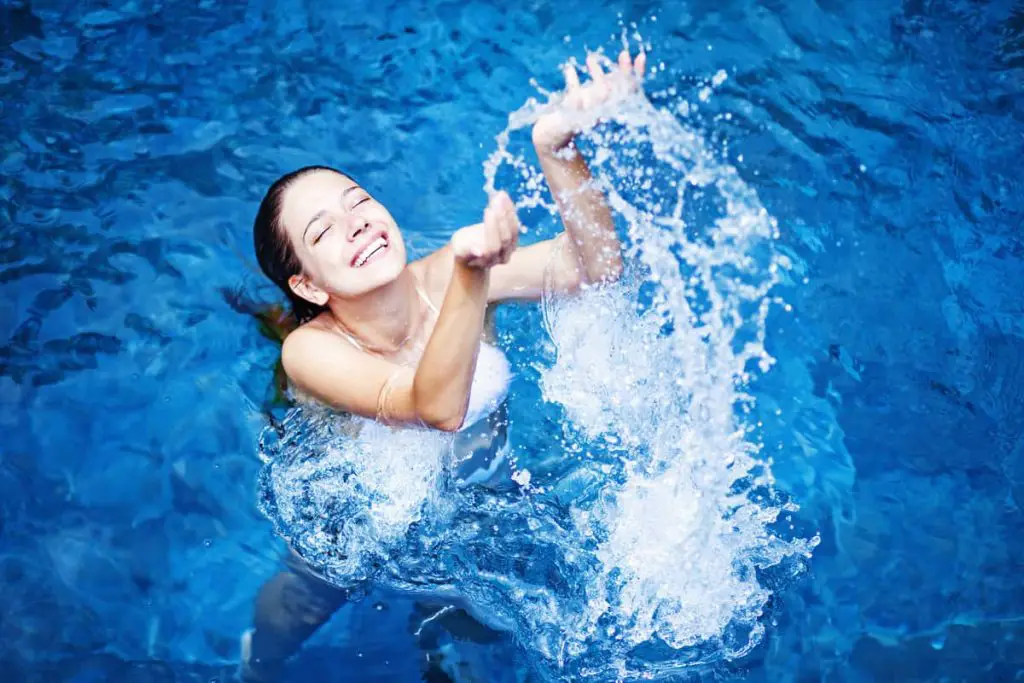The swimming pools I see always look picturesquely blue when browsing through catalogs or product listings on the Internet. It’s not just in advertisements either; friends and family with pools show off that perfect color as well. Why are pools blue like this?
Swimming pools look blue because of the way water reacts to the light spectrum. Water will absorb the red light parts first, leaving the blue light to travel throughout the water slowly. Deeper water will look darker blue.
If you have yet more questions about the blueness of swimming pools, you’ve come to the right place. In this article, we’ll discuss further why pools look blue, how you can make your pool the right hue (and keep it that way), and whether doing so requires dye.

What Turns Pool Water Blue? A Scientific Explanation
Nothing is more inviting than gorgeous, clear blue waters. Swimming pools almost always boast blue water, but why is that?
Well, part of it could be the pool liner, with most people selecting blue liners because that’s the “color” of water. However, the real reason your pool looks blue is due to how water and light interact.
For instance, your swimming pool can absorb red wavelengths with ease. Yet blue wavelengths don’t absorb as quickly. Why is that? Well, the water is absorbing sunlight, which is white. Although white light appears colorless, in actuality, it comprises all colors in the light spectrum.
So the water goes from left to right, to so speak, on the visible spectrum when absorbing the light at different wavelengths. Red is absorbed fastest because it’s the first color in the visible light spectrum (ROYGBIV.)
When the red is out of the equation, the light will look bluer. The deeper your pool water, the richer the blue color is, whereas a shallow pool will be only somewhat blue but still noticeably so.
How to Make Pool Water Blue
Yet sometimes, when you gaze into your swimming pool, you don’t see sparkling blue water. Instead, you’re greeted by unappealing hues such as brown or green. This isn’t a light trick but is often indicative of dirt and/or algae.
How do you get your pool water blue again? Here’s what you do.
Buy a Pool Water Testing Kit
Although a green pool could mean you have algae, it’s not always as cut and dried as that. Misdiagnosing the issue with your swimming pool can be costly as you buy the wrong treatment. You also miss out on days, if not weeks, that you could have spent in the pool.
A pool water testing kit will reveal precisely what the problem is. This Taylor Technologies testing kit is an Amazon’s Choice product. In the kit is everything you need to test for cyanuric acid, calcium hardness, total alkalinity, and free chlorine, as well as the pool’s pH levels. You even get a water gram for making sense of the results.
Shock the Pool
If your problem is algae, then you’ll have to shock your pool. Shocking involves pouring chemicals into the water to increase free chlorine levels quickly. This process will kill bacteria, chloramines, and algae.
Make sure your shock is a cal-hypo product; other types of shock can lead to chlorine locking. When this happens, the chlorine in the pool travels through more slowly. Not only can this burn your eyes when you swim because of all the lingering chlorine, but the problem is severe enough that you often have to drain some of the water in your pool and replace it.
Use Algaecide
Next, you need algaecide, which can kill off any remaining traces of algae in all colors, such as black, yellow, and green. Algaecide is also a preventative product that’s supposed to ward off future recurrences of algae.
Wait until it’s been 24 hours since you shocked the pool, then add the algaecide. Read the instructions on your algaecide product, as the quantity you’ll need varies depending on your pool’s volume.
Test Again
With the algae removed and your pool stabilized, use your testing kit and see how its results have changed. Your pool should be ready to use!
Tips for Keeping Your Pool Water Blue
Now that your pool is looking undeniably bluer than it ever has, you want to maintain that gorgeous shimmering hue. That will require regular maintenance for the duration of the active pool season. Here are the tasks you’ll need to incorporate into your regular routine.
Daily Routine
Keeping your pool tidy is one of the best ways to ensure it’s as blue as the ocean deep. With your skimmer, remove everything on the top surface of your pool, including bugs (alive and dead), leaves, sticks, flower petals, and the like.
Depending on the last time you chlorinated, it might be a good time to do so again. If you do apply chlorine, you want to wait until everyone has already used the pool. Add the chlorine granules near the edges of your pool.
Weekly Routine
Every week, use your testing kit to test the pool water. The ideal swimming pool pH is 7.2 to 7.6. If your pool isn’t within that range, then apply an alkaline or acidic additive. Keep in mind that thunderstorms can disrupt the pH due to the rainwater that’s splashed into your pool. Always test the pool’s pH three hours after the rain stops.
Inspect the pump and ensure it’s working well. Backwash the filters. Check the pump baskets. If they’re full, you need to clean them. Ideally, you’ll want to empty the baskets a few times per week, not just once. Use an algaecide every week. Shock the pool overnight at least once weekly.

Can You Dye Pool Water Blue?
A healthy pool will always look blue, but you’re not satisfied with your level of blueness. You want a richer, purer, more noticeable color. In that case, you might consider dyeing your pool water. Your options are not only blue, but green, red, and other hues as well.
A product like Robarb Super Blue isn’t just for show. This pool dye removes water cloudiness, keeping particles out of the water so your algaecide works even more efficiently. You can use Super Blue with ozone, ionization, salt, biguanide, bromide, or chlorine sanitizing systems.
Super Blue is supposed to be biodegradable and non-toxic. So how do you use it? Here are the instructions as provided by Robarb.
- Take 5 gallons of pool water and transfer it to a bucket or container. Then apply an ounce of Super Blue to the water. Robarb says not to add the product directly to the pool since it’s ultra-concentrated. It must be diluted first.
- Pour the contents of the bucket or container back into the pool, sticking close to the edge as you do. If you can, you might strain the poured water through a skimmer.
- Turn your filter on and leave it running over the next eight hours.
While most pool dyes have been proven to be unharmful for everyday use, some pool owners have reported that using dye has thrown off their pool’s chemical balance. This would require a lot of remediation, so the color of the pool would be the least of your problems.
A much faster way to make your pool look blue that’s completely chemical-free is through LED pool lights. These lights on Amazon are low-priced and can switch between 16 colors. You can also adjust the brightness at five different levels to get a pale blue or a brighter color.
Conclusion
Swimming pools are usually blue due to the way the water absorbs red light faster. You can always try dyeing your pool to create a blue effect, but LEDs are easier and safer. If your pool has turned brown or green, it’s a sign that it’s time to shock the pool and apply an algaecide!
